On March 24th,
1944 in Rome the nazi SS massacred 335 people (see
the list), in the Ardeatine caves,
since then named Fosse Ardeatine, in retaliation for an act of
war carried out by partisans against a patrol of German soldiers
in via Rasella, in the city center.
These are the bare facts, the Nazis killed a huge number of people,
shooting them in the nape, one by one, then making the caves collapse,
four days later, to conceal the crime, just like a vulgar murderer
who tries to hide the corpse of his victim to avoid being discovered.
The nazis even murdered an elderly lady who was picking chicory
near the Caves, just to eliminate a troublesome witness.
From this linear example of dull nazi brutality (nazi, not German,
please), a continuous and incessant hearsay was engendered, which
began immediately after the massacre, as an idiot and ignorant
platitude, oftentimes also disingenuous, and common among many
people, according to which the partisans were actually to blame
for the massacre, because they were supposed to turn themselves
in to the nazi police, in obedience to an alleged ultimatum, and
would thus have avoided the massacre.
Those who spread this lie probably do not know that between Via
Rasella attack and Fosse Ardeatine massacre less than 24 hours
passed, most of which under curfew, that there was no call for
the responsibles for to surrender, nor any threat of retaliation
if the culprits hadn't turn themselves in, as clearly admitted
by the same nazi criminals during their trial. The massacre had
been decided in advance, and would have happened even if the Partisans
who had carried out the attack had turn themselves in.
The Rome's newspaper "Il
Messaggero" so reported the news on March 25th,
1944, the day after the massacre: "On the afternoon of
March 23rd, 1944, criminals carried out
an attack on a German police column passing through via Rasella
(...) the German High Command is determined to break off the activities
of these wicked bandits and thus ordered that for every German
killed ten communist criminals followers of Badoglio will be shot.
The order has already been executed".
If it weren't tragic, the contrast between "will be shot"
and "already been executed" would be ridiculous,
and it clearly explains how the day after the massacre the squalid
nazi minions ("Il
Messaggero" was nothing different then) could present
a war crime as a just punishment for a criminal act.
Alessandro Portelli describes well the immediate unleashing of
the blame reversal mechanism: the murderers are exonerated and
the the partisans are the culprits. Indeed, the Vatican newspaper
"L'Osservatore romano"
of March 26th, two days after the massacre,
wrote of "three hundred and twenty people sacrificed for
the culprits who escaped arrest", thus denying the essence
of the attack in Via Rasella as a legitimate act of war, fighters
against fighters, but accrediting the thesis of the partisan action
as a crime, which is followed by a deserved punishment, even a
sacrifice, giving the infamous massacre a sacred value.
As a proof of the chaotic situation of information passing through
between southern Italy, occupied by the Allied troops, and the
center-north occupied by the Nazi-fascists, see the article of
l'Unità, the newspaper of
the Communist Party of 2nd April, printed in Naples, which reported
of a massacre occurred on March 27th at the Colosseum, reporting the
number of 320 victims, the same initially decided for retaliation.
L'Unità got the chance to exalt the fight of Partisan fight
of the Italian people against the Nazi-fascists.
Even three days after the liberation of Rome, on 7 June, 1944,
Il Messaggero,
which in the meantime had completely changed its political line,
reported on the pilgrimage to the Caves (called "Domitilla
caves", due to the proximity of the cataclysms of the same
name), of the relatives of the missing , to look for news of their
loved ones, and assuming a number of victims of around 400, which
rose to 600 with others massacred in the Tor di Quinto area.
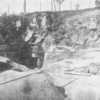
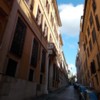
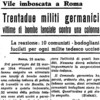
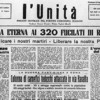
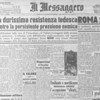

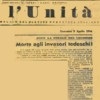
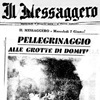
How should we judge those
who, decades later, are to such an extent wretched to try at all
costs to excuse those who have committed a crime against humanity,
on the other hand trying to blame those who have defended, at
the risk of their own life, the freedom of his country, restoring
its honor, which had been lost during the fascist dictatorship
and war? Among other things the same Allies had repeatedly urged
the Italians to rise against the nazists and fascists.
The coroner Attilio Ascarelli, who
performed the autopsies to the martyrs of the Fosse Ardeatine,
allowing them to have an appropriate burial, despite the attempt
of the Nazis to conceal and destroy the corpses (see the plaque in his memory in the Memorial),
wrote that Via Rasella attack, "was the outburst of a
state of mind which necessarily arose from the atmosphere of hatred,
fear and from the inhumane continued persecution and provocation"
and defined the massacre of the Fosse Ardeatine" the cruel
satisfaction of a brutal vindictiveness". (Ascarelli)
Rome was only formally an "open city", but it was actually
under the occupation of nazis and fascists, who carried out continuous
sweeps and shootings: just think that in Forte
Bravetta, at the age of the Fosse Ardeatine massacre, more
than fifty antifascist fighters had been shot, almost all for
"anti-German activities". Also on October 16th,
1943, the nazis and the fascists had seized from the ghetto of
Rome "open city" 1,259 persons, deporting 1,014 of them
to concentration camps, whence only sixteen of them came back
home, more than 800 died in the gas chambers one week after the
roundup. (Spizzichino)
The Roman citizens
reacted to this gory oppression by lawful acts of war, by exercising
the right to fight and free their own country from a foreign occupation
and from a home dictatorship who was standing only for the support
of foreign occupiers.

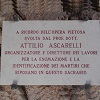
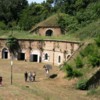

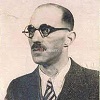
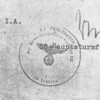
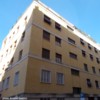



Therefore the attack on
the nazi column was a legitimate act of war, and the brave Italian
men and women that carried it out, wholly deserve the Medals of
Valor that were awarded to them. After via Rasella attack the
nazis stopped carrying out military operations and massing
troops in Rome, and as a result, the Allies stopped bombing
the city, thus allowing to save a huge number of human lives.
Anyway, in Rome many armed attacks against the nazis and fascists
were performed, not followed by any reprisal, and, on the other
hand, many Roman citizens were arrested, deported and murdered,
without any "justification" on a reprisal for acts of
war. What are we going to do then about the despicable individuals
that define the Fosse Ardeatine massacre as an "unavoidable"
reprisal?
In 1965 Sergio Piperno Beer,
at the time President of the Union of Italian Jewish Communities,
included the massacre in the worst kind of crimes, those perpetrated
in the name of a "justice" that was merely "a
tragic mocking mask on the face of a horde of criminals, who,
in the end, were also concerned about the ultimate fate of themselves
and of their impositions". Piperno added: "at
the Fosse Ardeatine they didn't actually want to punish the prisoners
under accusation for rebellion, but rather terrorize the entire
city with the ruthless demonstration of an incontestable rule
and with an exorbitant number of «executed persons»". (Ascarelli)
Moreover, according
to Silverio Corvisieri, the nazis tried to accredit the lie that
the 335 victims had already been sentenced to death for acts of
resistance, even before Via Rasella attack, confirming the fact
that the reprisal of the Fosse Ardeatine was perceived even by
the nazis as something huge and excessive.
Once the historical truth is re-established, clarifying that there
was no call on the makers of the attack to turn themselves in,
in order to avoid a retaliation, even because the very short time
makes this hypothesis impossible, we must not forget that twenty
days before the roundup of the Roman Ghetto, cited above, the
nazis had forced the Roman Jewish community to deliver a ransom
of 50 kg of gold for not to deport the heads of the families.
Once the nazis grabbed the ransom, however, they deported to concentration
camps not only the heads of the families, but all the Jews they
managed to capture, including babies and octogenarians. And still
somebody has the gall (or worse) to tell the tale of the gentlemen
nazis who would have fairly freed the prisoners bound for the
Fosse Ardeatine, if only the authors of the attack of Via Rasella
had turned themselves in!
It should be remembered the notice
sent by the SS to the families of the victims of Fosse Ardeatine
massacre, by which, over a month after the massacre, they informed
the relatives of the death of their dear ones and invited in
German to go and retrieve the belongings of their loved ones
in via Tasso prison.The Catholic Church,
after at least fifteen years of excellent relations with the fascist
dictatorship, considered the nazis perpetrators of the carnage
and the partisans who had carried out the attack in via Rasella
equally guilty, with a promptness not shown on the occasion of
the raiding of the Jews in the Ghetto of Rome, six months earlier.
A year later the Catholic Church would help many of the worst
fascist and nazi war criminals to leave their countries, escaping
the trials that awaited them for the atrocities they committed.
(Lupo)
Gratitude
I remain grateful
to those who fought in the Resistenza in Rome, in actual fact
succeeding, with Via Rasella attack, to drive the nazis away from
Rome, clarifying to everybody that the Romans couldn't stand the
occupation of the nazi torturers and their fascist servants.
So, my hearty thanks go to those who have performed or collaborated
to perform the act of war against the nazis in via Rasella, that
is Rosario
"Sasà" Bentivegna (Paolo), Carla
Capponi (Elena), Pasquale Balsamo, Mario
Fiorentini (Gandi), Lucia Ottobrini
(Maria), Marisa Musu (Rosa), Franco Calamandrei (Cola), Fernando
Vitagliano, Raoul Falcioni, Carlo Salinari
(Spartaco), Silvio Serra, Francesco
Curreli, Giulio Cortini, Laura Garroni, Duilio Grigioni, Ernesto
Borghesi, who fought and risked their lives for my freedom, even
though I wasn't even born yet.




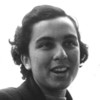




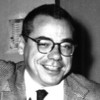

Thanks also Giaime Pintor, Bruno Buozzi and all the other antifascist fighters who died to make Italy free from nazi and fascist shame, and Maria Teresa Regard (Piera) Sandro Pertini, Adriano Ossicini, Maurizio Ferrara, Carlo Lizzani, Vasco Pratolini, Aldo Natoli, and all the others who survived and could contribute to build democratic Italy, even if today this country is far-away from the one they all dreamt in these years.
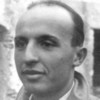



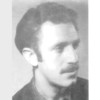


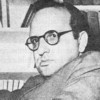

Who the
victims were?
The 335 persons murdered
at the Fosse Ardeatine were all males, ranging in age from 15
years of Michele Di Veroli to 74 of Mosè
Di Consiglio, as many as 27 were under twenty, 113 under thirty.
They were all arrested in Rome, but little more than half of them
(174 people) were born in Rome or in the province. As for their
political affiliation, according to reports, 58 of them made reference
to the Partito d'Azione (Action
Party), 42 to the Movimento Comunista
d'Italia (Communist Movement of Italy), a large group of Communist
partisans who did not agree the main Communist Party, and were
known by the name of the newspaper they published Bandiera
Rossa (Red Flag). Thirty of the victims belonged to the Partito Comunista Italiano (Italian Communist
Party), while 16 were members of the Italian Socialist Party,
which from 1943 to 1947 took the name of PSIUP,
Partito Socialista Italiano di Unità Proletaria (Italian
Socialist Party of Proletarian Unity). Finally 26 victims were
members of the Comitato di Liberazione Nazionale
(National Liberation Committee), a common structure made by the
main antifascist movements.
Under solicitation of the Gestapo commander in Rome, who pressed
to have a huge number of Jews among the people bound for the massacre,
75 of the victims of the Fosse Ardeatine were Jews, as reported
by the Center for Contemporary Jewish Documentation on the Shoah
victims website,
to which Aldo Finzi should be added, a convert jew, formerly fascist
and undersecretary for Mussolini, and then resistance fighter.
Many Jews were also anti-fascist fighters.
Several Fosse Ardeatine martyrs were residents of Via Rasella,
raked in the immediacy of the
attack, as if anybody could think that someone would organize
an attack under their homes' windows, but the nazis' blunt brutality
didn't mind such details. Actually it seems that the initial order
was to exterminate all the inhabitants of the neighborhood.
Among the Fosse Ardeatine martyrs, 68 were servicemen (42 officers,
9 non-commissioned officers and 17 soldiers); also among them
many anti-fascist fighters could be find: 43 of them were members
of the Underground Military Front, which gathered the servicemen
that after the armistice had not agreed to join the puppet government
of the fascist republic, nor disbanded. Thirty-six victims (including
24 servicemen) were awarded the gold medal for military valor,
while 10 were awarded the silver medal. Father
Pietro Pappagallo, the only priest among the victims, was
awarded the gold medal for civil merit.
The activitie of the victims of the massacre were very different:
91 were traders or employed in the trade, 51 craftsmen, 45 employees,
19 workers or assimilable, 21 professionals, 12 farmers or laborers,
9 students, 6 entrepreneurs, 6 artists, 5 teachers.

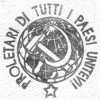
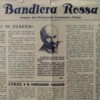
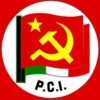
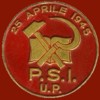
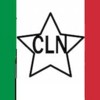



The culprits
Some of the Italians
who had worked to provide the nazis with the prisoners to be massacred
(see the list made by Rome's
police) have paid with their life in the immediate closeness of
the Liberation, others have managed to infiltrate into the recesses
of the new democratic State and therefore they got off scot-free.
As for the nazis, a tacit agreement between the German and Italian
authorities, both infiltrated by former nazis and fascists, allowed
many of the perpetrators of Fosse Ardeatine massacre to be shown
as dead or untraceable (Wiegrefe),
while only a few have paid, very late, among other things. Only
one of them has served over thirty years in prison, until they
let him escape. Another one lived free in Argentina until the
age of eighty (none of the victims has reached this age!), then
he finally got a life sentence, however availing himself of house
arrest.
Therefore, who can say that crime doesn't pay!
As an additional information, I specify that I haven't intentionally
reported any photo or name of the torturers of the Fosse Ardeatine,
because I thought there was no need to publish the features or
the names of those who have committed such a horrific act against
human species. Damnatio memoriae is probably not enough,
but it's better than nothing, and I do not feel like dirtying
my website with faces and names of murderers and torturers, among
other things almost unpunished.
The Memorial
Immediately after the liberation of Rome, just over two months
after the massacre, the Allied occupation authorities wanted to
cover the quarries with earth and place a plaque on the site of
the massacre. The families of the victims, led by General Simoni's
wife, with a strong opposition to the project, obtained the exhumation
of the bodies and individual burial, after the recognition of
the bodies, thanks to the very hard and difficult work of the
medical examiner Dr. Attilio Ascarelli and his coworkers.
So the place of the massacre, which lies in Rome in Via Ardeatina
174, has been turned into a memorial, where also the mausoleum
of the victims was built. It can be visited on: Mon-Fri 08:15 - 15:30 / Sat-Sun 08:15 -
16:30, the Museum
can be visited on: Mon-Fri
08:15 - 15:15 / Sat-Sun 08:15 - 16:15.
Memorial and Museum are closed: January 1st,
Easter Sunday, May 1st, August 15st,
December 25st and 26th. The website is http://www.mausoleofosseardeatine.it/,
phone number +39 06 6795629, WhatsApp +39 392 4484043, e-mail
address: info@mausoleofosseardeatine.it.
The entrance is free.
One of the plaques inside te
caves' tunnels says: «Fummo trucidati in questo luogo
perché lottammo contro la tirannide interna per la libertà
e contro lo straniero per l'indipendenza della Patria. Sognammo
un'Italia libera, giusta, democratica. Il nostro sacrificio ed
il nostro sangue ne siano la sementa ed il monito per le generazioni
che verranno» ("We were murdered in this place
because we fought against a home tyranny for freedom and against
the foreigner for the independence of our Fatherland. We dreamt
of a free, just, democratic Italy. Be our sacrifice and our blood
the seed and the warning to the generations to come").
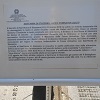

On the back of the mausoleum there are two slabs with the list of the 394 civilian victims of the Nazi massacre of Sant'Anna di Stazzema (province of Lucca, Tuscany) on August 12th, 1944, donated by the Tuscan town municipality after they were damaged in 2015 by a storm. The square in front of the entrance to the caves is instead dedicated to the victims of the Nazi-fascist massacre in Marzabotto (province of Bologna, Emilia-Romagna) where 1,830 unarmed people were murdered between 29 September and 5 October 1944.

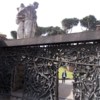

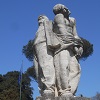
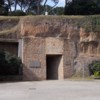
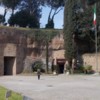
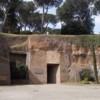

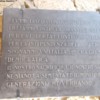
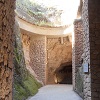
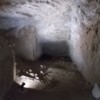

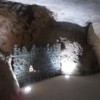
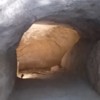

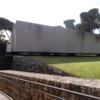
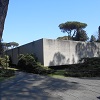

Mwmory
In 1968 the US composer William Howard
Schuman (1910-1992), after a visit to the Fosse Ardeatine
in 1967, composed the Symphony n. 9 "Le Fosse Ardeatine"
("The Ardeatine Caves"). In 2019, maestro Riccardo Muti conducted the symphony,
on the occasion of the 75th anniversary of the massacre, with
the Chicago Symphony Orchestra, and in 2024,
on the 80th anniversary of the massacre,
at the Sala Santa Cecilia of the Auditorium Parco della Musica
in Rome with the youth orchestra he himself created for the improvement
and growth of musicians under 30. Listen on YouTube
to the symphony performed by the Philadelphia Orchestra conducted
by Eugene Ormandy and by the Seattle
Symphony Orchestra conducted by Gerard
Schwarz (1st
part, Anteludium, 2nd
part, Offertorium and 3rd
part, Postludium).





In conclusion
I suggest to read
Alessandro Portelli's book "The
Order Has Been Carried Out: History, Memory and Meaning of a Nazi
Massacre in Rome" (New York, NY: Palgrave Macmillan,
2003, ISBN 978-1-403-96208-9), who told, by far more effectively
and exhaustively than I could ever do, the story of Via Rasella,
of the Fosse Ardeatine and what followed, including the infamous
campaign against the Partisans, that had a resurgence in the late
'90s, on the occasion of the trial to one of the butchers of Fosse
Ardeatine massacre, who still survived.

Bibliographic
references:
AA.VV.
(1978) Quaderni della Resistenza laziale, n. 8. Regione Lazio,
Stilgraf, Rome, Italy
ASCARELLI Attilio (1965) Le Fosse Ardeatine. Canesi, Rome,
Italy.
CORVISIERI Silverio (2005) Bandiera rossa nella resistenza romana.
Odradek, Rome, Italy. webpage
D'AGUANNO Claudio (2004) Un magma resistente. www.fisicamente.net
this link is no more available link
GLIELMI Alessia A. (2020) Il corpo e il nome. Inventario della
Commissione tecnica medico-legale per l’identificazione delle
vittime delle Fosse Ardeatine (1944-1963). Viella, Rome, Italy.
webpage
LUPO Salvatore (2004) Partito e antipartito. Una storia politica
della prima Repubblica (1946-78). Donzelli, Rome, Italy. webpage
ORLANDI POSTI Orlando (2004) Roma '44. Le lettere dal carcere
di via Tasso di un martire delle Fosse Ardeatine. Donzelli,
Rome, Italy. webpage
PORTELLI Alessandro (2003) The Order Has Been Carried Out: History,
Memory and Meaning of a Nazi Massacre in Rome. Palgrave Macmillan,
New York, NY, USA.
RAGONE Ottavio, SANNINO Conchita (editors) (2024) Roma
1944. Le Fosse Ardeatine e la Liberazione ottant'anni dopo. La
Repubblica, GEDI News Network S.p.A.,Turin, Italy. webpage
QUASSIA Piero (2013) 25 Aprile. Perchè non ricordare Cosimo
Di Micco? Triggiano Democratica. this link is no more available
link
S.A. (2001) Montesacro e Valmelaina nei 9 mesi della occupazione
nazista di Roma. www.storiaxxisecolo.it link
SPIZZICHINO
Giancarlo (2012) La deportazione a Roma. in "Le leggi
razziali e la persecuzione degli ebrei a Roma, 1938-1945".
Edited by Silvia Haia Antonucci, Pierina Ferrara. Marco Folin,
Manola Ida Venzo. MuMeLoc, Cerreto Guidi, Archivio Storico
della Comunità Ebraica di Roma. link
TROISIO Armando (2014) Roma sotto il terrore nazista. Castelvecchi,
Rome, Italy.
WIEGREFE Klaus (2012) Unpunished Massacre in Italy: How Postwar
Germany Let War Criminals Go Free. Der Spiegel OnLine International,
January 19, 2012 link







Links: (verified on May
2nd, 2024)
Ada
Holtzman Home Page link
ANFIM - National
Association of Italian Families of the Martyrs Fallen for the
Homeland's Freedom link
ANPI (National
Association of Italian Partisans) Women and Men of the
Resistenza link
ANPI (National Association of Italian Partisans) Fosse Ardeatine
link
Circolo Rosselli
Milan link
Jewish Community of Rome link
Foundation Center for Jewish Contemporary Research CDEC - Digital
Library link
Holocaust
Encyclopedia link
Italian Ministry
of Defense link
ArchiDiAP
- monument to the Martyrs of Fosse Ardeatine link
Resistenzaitaliana.it link
Bologna History
and Memory link
 page created: March 21st, 2016 and last updated: May 22nd, 2024
page created: March 21st, 2016 and last updated: May 22nd, 2024